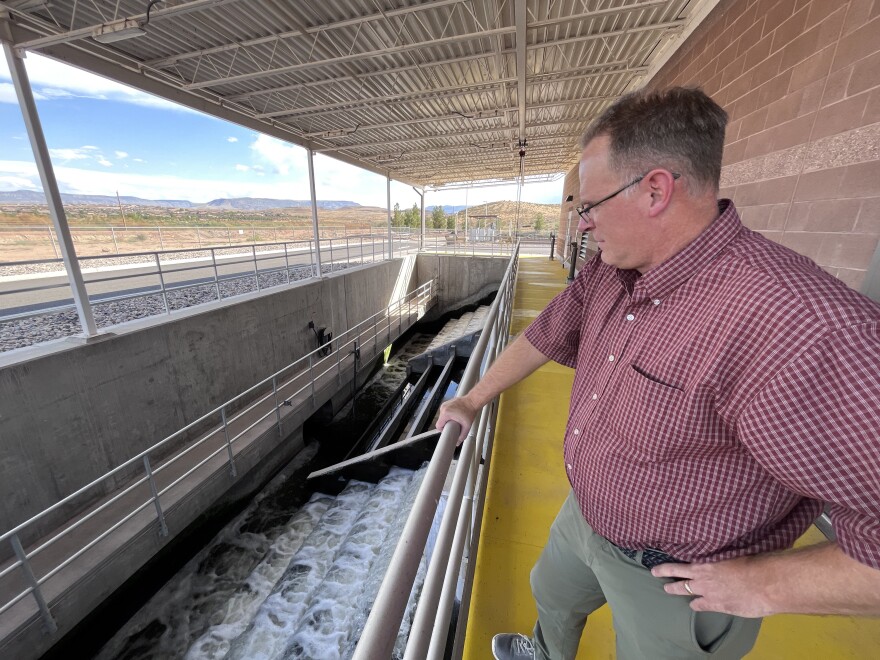There aren’t a lot of ways to find more water in the desert.
Precipitation is unreliable. Underground wells are limited. But there’s one water source that’s expected to grow along with St. George’s population in the coming years: the wastewater that comes from people flushing their toilets and taking showers.
Outside the city’s water reclamation plant, St. George water services director Scott Taylor stood on a platform overlooking a concrete waterfall cascading into an underground pipe. It’s treated sewage that could have been recycled for later use, but the city doesn’t have a place to store it.
In one day, he estimated, 11 million gallons flow out that pipe, into the Virgin River and ultimately to Nevada’s Lake Mead.
“It lets me know that we have a resource we can better develop and use,” Taylor said. “That's the 20-year goal right there.”
St. George is betting big on a plan to hold onto more of its sewage by cleaning it, building a new reservoir to store it and then reusing it to irrigate the region’s farms, parks and lawns. That’s why the city is now finalizing plans for the Graveyard Wash Reservoir, a 650 million-gallon water bank that will be dedicated to storing recycled wastewater for a non-rainy day.
The idea is to use the reclaimed water from Graveyard Wash for irrigation and save more of the city’s current water supplies for drinking, or culinary, water. In a place where roughly half of all residential water use goes to landscaping, Taylor said, that change could have a lot of positive ripple effects.
“For every gallon of reuse water that we can use outside,” Taylor said, “that frees up that gallon of culinary water for future growth of the area.”
Reusing more wastewater is a critical part of the Washington County Water Conservancy District’s 20-year plan to keep this fast-growing city from running dry. The plan calls for recycled sewage to make up more than half of the additional water the region needs to serve a population that will nearly double in that timespan.
“We live in a desert,” district manager Zach Renstrom said.
“We have very, very limited resources, specifically water … so now we just have to get more creative.”

The city expects to begin building the Graveyard Wash Reservoir early next year. After 12 to 18 months of construction and three or four months to fill it up, the reservoir could be ready by the summer of 2025.
Taylor, the St. George water director, estimated the cost of building Graveyard Wash Reservoir will be $20 million, with roughly three-fourths of that funded by state grants.
Once Graveyard Wash is filled, the plan is to eventually build at least two more reservoirs to expand the region’s ability to store recycled wastewater — Dry Wash Reservoir near Ivins and Warner Valley east of St. George.
“It's expensive. We understand that,” Renstrom said. “But when you get low on resources, you look at these more expensive resources.”
But reusing wastewater isn’t as expensive as some of the region’s other options. Renstrom said cleaning sewage to culinary standards costs about three times as much as doing it for irrigation.
Southwest Utah has long hoped the Lake Powell Pipeline — a proposed 140-mile, $2.2 billion-dollar tube to bring water from the dwindling reservoir on the Colorado River — would save the day. But as megadrought and thirsty farms and cities draw Lake Powell to record lows, the pipeline plan may no longer be something St. George can bank on.
Around St. George, recycled wastewater already flows through the sprinklers at several golf courses, more than a dozen schools and a majority of the city’s irrigated parks.
Renstrom expects a lot of the reservoir’s water to go toward farm fields in the beginning, but he sees more going toward residential landscaping in the coming years as additional neighborhoods get connected to the network of pipes. The city began requiring developers to build homes with a separate water system for irrigation in recent years, so the number of residents who can tap into this reused water will grow as the city expands.
“For the next 20 years, [reclaimed water will] be the most significant amount of water that we'll be able to develop,” Renstrom said. “That reuse is what's going to really be driving the economic growth in this area.”





